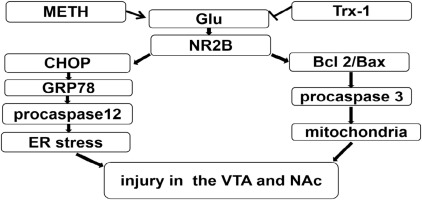当前位置:
X-MOL 学术
›
Neurotoxicology
›
论文详情
Our official English website, www.x-mol.net, welcomes your
feedback! (Note: you will need to create a separate account there.)
Thioredoxin-1 blocks methamphetamine-induced injury in brain through inhibiting endoplasmic reticulum and mitochondria-mediated apoptosis in mice.
NeuroToxicology ( IF 3.4 ) Pub Date : 2020-03-20 , DOI: 10.1016/j.neuro.2020.03.006 Lihua Yang 1 , Ningning Guo 2 , Wei Fan 2 , Chunmin Ni 3 , Mengbing Huang 2 , Liping Bai 2 , Le Zhang 2 , Xianwen Zhang 2 , Yunbo Wen 3 , Ye Li 2 , Xiaoshuang Zhou 2 , Jie Bai 2
NeuroToxicology ( IF 3.4 ) Pub Date : 2020-03-20 , DOI: 10.1016/j.neuro.2020.03.006 Lihua Yang 1 , Ningning Guo 2 , Wei Fan 2 , Chunmin Ni 3 , Mengbing Huang 2 , Liping Bai 2 , Le Zhang 2 , Xianwen Zhang 2 , Yunbo Wen 3 , Ye Li 2 , Xiaoshuang Zhou 2 , Jie Bai 2
Affiliation

|
Methamphetamine (METH) has been reported to induce endoplasmic reticulum (ER) stress and neuronal apoptosis in the central nervous system (CNS) during the development of addiction. Thioredoxin-1 (Trx-1) is a redox regulating protein and plays an important role in inhibiting apoptosis and protects neurons from cytotoxicity through ER and mitochondria-mediated pathways. Our previous study has been reported that Trx-1 protects mice from METH-induced rewarding effect. However, whether Trx-1 plays the role in resisting METH injury is still unclear. Here, we aim to investigate whether Trx-1 participates in the regulation of METH-induced CNS injury via ER stress and mitochondria-mediated pathways. Our study first repeated the conditioned place preference expression induced by METH. Then we detected and found that METH increased the expression of N-methyl-d-asparate (NMDA) receptor subunit 2B (NR2B) and the level of glutamate (Glu) in the ventral tegmental area (VTA) and nucleus accumbens (NAc), while Trx-1 overexpression suppressed the increases. We further examined ER stress-related proteins and mitochondrial apoptosis pathway in the VTA and NAc, and found that METH increased the expressions of glucose regulated protein 78 (GRP78), C/EBP homologous protein (CHOP), and Bax, as same time decreased the expressions of procaspase12, Bcl-2, and procaspase3, while Trx-1 overexpression blocked these changes. These results indicate that Trx-1 blocks METH-induced injury by suppressing ER stress and mitochondria-mediated apoptosis in the VTA and NAc via targeting glutamatergic system.
中文翻译:

硫氧还蛋白-1通过抑制小鼠内质网和线粒体介导的凋亡来阻断甲基苯丙胺对脑的损伤。
据报道,甲基苯丙胺(METH)在成瘾过程中会诱导中枢神经系统(CNS)内质网(ER)应激和神经元凋亡。硫氧还蛋白-1(Trx-1)是一种氧化还原调节蛋白,在抑制细胞凋亡中发挥重要作用,并通过ER和线粒体介导的途径保护神经元免受细胞毒性。我们以前的研究已经报道了Trx-1保护小鼠免受METH诱导的奖励作用。但是,Trx-1是否在抵抗METH损伤中发挥作用尚不清楚。在这里,我们旨在调查Trx-1是否通过内质网应激和线粒体介导的途径参与METH诱导的中枢神经系统损伤的调节。我们的研究首先重复了由METH诱导的条件性位置偏好表达。然后我们发现METH增加了腹侧被盖区(VTA)和伏隔核(NAc)中N-甲基-d-天冬氨酸(NMDA)受体2B(NR2B)的表达以及谷氨酸(Glu)的水平, Trx-1过表达抑制了这种增加。我们进一步检查了ER应激相关蛋白和VTA和NAc中的线粒体凋亡途径,发现METH增加了葡萄糖调节蛋白78(GRP78),C / EBP同源蛋白(CHOP)和Bax的表达,同时降低了Trasp-1的过表达阻止了这些变化,而procaspase12,Bcl-2和procaspase3的表达。这些结果表明,Trx-1通过靶向谷氨酸能系统来抑制VTA和NAc中的ER应激和线粒体介导的细胞凋亡,从而阻断了METH诱导的损伤。
更新日期:2020-03-20
中文翻译:

硫氧还蛋白-1通过抑制小鼠内质网和线粒体介导的凋亡来阻断甲基苯丙胺对脑的损伤。
据报道,甲基苯丙胺(METH)在成瘾过程中会诱导中枢神经系统(CNS)内质网(ER)应激和神经元凋亡。硫氧还蛋白-1(Trx-1)是一种氧化还原调节蛋白,在抑制细胞凋亡中发挥重要作用,并通过ER和线粒体介导的途径保护神经元免受细胞毒性。我们以前的研究已经报道了Trx-1保护小鼠免受METH诱导的奖励作用。但是,Trx-1是否在抵抗METH损伤中发挥作用尚不清楚。在这里,我们旨在调查Trx-1是否通过内质网应激和线粒体介导的途径参与METH诱导的中枢神经系统损伤的调节。我们的研究首先重复了由METH诱导的条件性位置偏好表达。然后我们发现METH增加了腹侧被盖区(VTA)和伏隔核(NAc)中N-甲基-d-天冬氨酸(NMDA)受体2B(NR2B)的表达以及谷氨酸(Glu)的水平, Trx-1过表达抑制了这种增加。我们进一步检查了ER应激相关蛋白和VTA和NAc中的线粒体凋亡途径,发现METH增加了葡萄糖调节蛋白78(GRP78),C / EBP同源蛋白(CHOP)和Bax的表达,同时降低了Trasp-1的过表达阻止了这些变化,而procaspase12,Bcl-2和procaspase3的表达。这些结果表明,Trx-1通过靶向谷氨酸能系统来抑制VTA和NAc中的ER应激和线粒体介导的细胞凋亡,从而阻断了METH诱导的损伤。











































 京公网安备 11010802027423号
京公网安备 11010802027423号